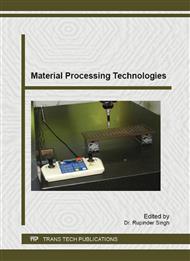[1]
M.O.H. Amuda and S. Mridha. An overview of sensitization dynamics in ferritic stainless steel welds. International Journal of Corrosion. 1-9, (2011).
DOI: 10.1155/2011/305793
Google Scholar
[2]
P. Atanda, A. Fatudimu and O. Oluwole. Sensitization study of normalized 316L stainless steel. Journal of Minerals & Materials Characterization & Engineering. 9(1), 13-23, (2010).
DOI: 10.4236/jmmce.2010.91002
Google Scholar
[3]
O. Dursun. An effect of weld current and weld atmosphere on the resistance spot weldability of 304 L austenitic stainless steel. Materials & Design. 29, 597-603, (2008).
DOI: 10.1016/j.matdes.2007.03.008
Google Scholar
[4]
F. Hayat, B. Kocabekir, R. Kacar, and S. Gunduz. An effect of heat input, weld atmosphere and weld cooling conditions on the resistance spot weldability of 316L austenitic stainless steel. Journal of Materials Processing Technology. 195, 327-335, (2008).
DOI: 10.1016/j.jmatprotec.2007.05.026
Google Scholar
[5]
S. Li, L. Deng, X. Wu, Y. Min and H. Wang. Influence of deep cryogenic treatment on microstructure and evaluation by internal friction of tool steel. Cryogenics. 50, 754-758, (2010).
DOI: 10.1016/j.cryogenics.2010.09.002
Google Scholar
[6]
R. Sharma. Effect of cryogenic treatment on sensitization of 304 stainless steel in resistance spot welding. M. Tech Thesis, Punjab Technical University, Jalandhar. (2011).
Google Scholar
[7]
O. Martin, P D. Tiedra, M. Lopez and J M. San. Use of EPR test to study the degree of sensitization in resistance spot welding joints of ALSI 304 austenitic stainless steel. Corrosion Science. 4, 1563-1570, (2011).
DOI: 10.1016/j.corsci.2011.01.036
Google Scholar
[8]
N. Muhammad, Y.H.P. Manurung, E. Haruman, S.K. Abas, G. Tham, K.M. Salleh and C.Y. Chau. Investigation on weld nugget and HAZ development of Resistance Spot Welding using SYSWELD's customized electrode meshing and experimental verification. Asian Journal of Industrial Engineering. 2, 63-71, (2010).
DOI: 10.3923/ajie.2010.63.71
Google Scholar
[9]
M. Pouranvari. Effect of welding parameters on the peak load and energy absorption of low-carbon steel Resistance Spot Welds. ISRN Mechanical Engineering. 3-7, (2011).
DOI: 10.5402/2011/824149
Google Scholar
[10]
Ó. Martín, P. De Tiedra, M. López, and M. San-Juan. Combined Effect of Resistance Spot Welding and Post-Welding Sensitization on the Pitting Corrosion Behavior of AISI 304 Stainless Steel. Corrosion. 69(3), 268-275, (2013).
DOI: 10.5006/0749
Google Scholar
[11]
N. Charde, F. Yusof and R. Rajkumar. Material characterization of mild steel, stainless steels and both steel mixed joints under resistance spot welding (2-mm sheets). The International Journal of Advanced Manufacturing Technology. 75(1-4), 373-384, (2014).
DOI: 10.1007/s00170-014-6158-z
Google Scholar
[12]
M.N. Jamasri, R. Ilman, T. Soekrisno. Corrosion fatigue behavior of RSW dissimilar metal welds between carbon steel and austenitic stainless steel with different thickness. Procedia Eng. 10, 649–654, (2011).
DOI: 10.1016/j.proeng.2011.04.108
Google Scholar
[13]
J.B. Shamsul and M.M. Hisyam. Study of spot welding of austenitic stainless steel type 304. Jol. Appl Sci Res. 3(11), 1494–1499, (2007).
Google Scholar


